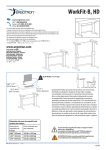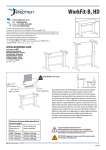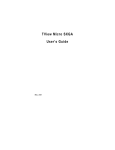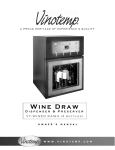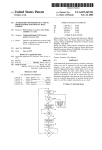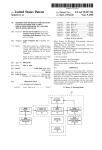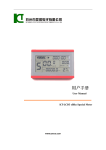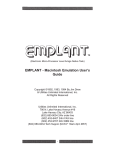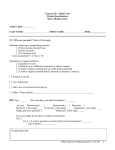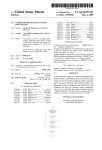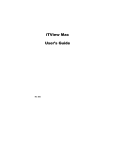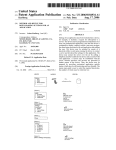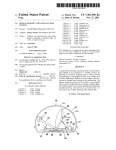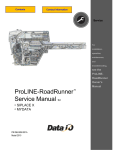Download UUM`MWMW / l_lE1l><l
Transcript
US006108010A Ulllted States Patent [19] [11] Patent Number: Boezeman et al. [45] 6,108,010 Date of Patent: *Aug. 22, 2000 [54] METHOD AND SYSTEM FOR A TRUESCALE MOTION PATH EDITOR 5,758,180 2,767,861 [75] Inventors: John Junior Boezeman, Cary; 5,818,462 10/1998 Marks et al. .......................... .. 345/473 ,793,382 both Christopher of NC- Joseph Paul Durham [73] 0309373 Corp" Armonk’ NY‘ [*] _ - Notice. 8/1998 YeraZunis et a . . FOREIGN PATENT Sato et a1.DOCUMENTS ............................. .. Assignee: International Business Machines - 5/1998 Duffy et a1. .......................... .. 395/806 6/1998 Kimura ....... .. 3/1989 European Pat O?- - 02032156 13/133451 iEumpean Pat’ Off‘ ' apan - - 2258790 This patent issued on a continued pros- ecution application ?led under 37 CFR 1.53(d), and is subject to the twenty year 12/1991 ............................ .. G06F 15/62 United Kingdom . . . 2303282 10/1993 Umted Kmgdom' OTHER PUBLICATIONS $226M germ provlslons of 35 USC‘ “Animated Software Documentation” IBM Technical Dis (aX closure Bulletin. vol. 34, No. 10A Mar. 1, 1992, pp. 27—28. Tutorial 12: Curves and Controllers; 3—D Studio Max Tuto [21l APP1- NO-I 08/896,817 [22] Filed: JuL 18 1997 51 I C17 rials, Autodesk, Inc., pp. 12—19 to 12—26 (Mar. 1996). Chapter 19: Shaping Objects, Corel Draw4 User Manual, ’ G06T 13 00 [52] 61 Ci [ ] [58] Corel Corporation, p. 118 (1993). 438 345/474 _' ' ' """"" " Field of Search . Primary Examiner—A mis R. Jankus ’ ..... .. 345/433, 438, Attorney, Agent, or Firm—A. Bruce Clay; Myers Bigel, Sibley & Sal-(W6C, RA~ 345/473—475 [57] [56] ABSTRACT References Cited _ _ _ _ _ A movement path is de?ned for a multimedia ob]ect in an US. PATENT DOCUMENTS 3’637’212 5,261,041 1/1972 Hurley " application development environment. A multimedia object is placed in a layout area of the application development 273/85 R 11/1993 Susman ....... .. environment. A movement path is then speci?ed Within the 395/152 1 t f th b- t - - t- d - Th b- 1 d . h h t 5355 314 ’ ’ 10/1994 Feigenbaum .. . . 364/420 ayou .area or 60 16C usmgapom mg Wm‘ 60 16C may either be dragged along the movement path by the 5,425,139 6/1995 Williams et al. 395/152 5,510,995 4/1996 Oliver .............................. .. 364/474.24 Pointing W196 or 1n “'1 ‘la Poms my 656 we W“ t 6 5,572,639 11/1996 Gantt ..................................... .. 395/133 5 577 185 11/1996 Tunnell et aL 395/173 Pomtmg devlce to de?ne the moveme?“ Path- ,Once the Path has been de?ned, the path may be easily modi?ed. The user . . d . . d. .d 1 . b 5:594:856 1/1997 Girard ......... .. 395/173 may 9199 or delete Points by Simply Selecting a 991m With the 5,619,628 4/1997 Fujita et a1_ __ 395/127 pointing device for addition or deletion. In addition, the user 5,678,001 10/1997 Nagel et a1. .......................... .. 395/173 5,680,619 10/1997 Gudmundson et al. .............. .. 395/701 may combine two or more movement paths into one. 5,692,144 11/1997 Thrush .................................. .. 395/339 15 Claims, 9 Drawing Sheets 10o \ UUM‘MWMW /9a / l_lE1l><l ?le 5m 1w Layout Qp?ons \llndow / R s: ¢= 1: [:7 ‘66 a 69 We i06_ 220 4 @ <9 U.S. Patent Aug. 22,2000 Sheet 1 of9 6,108,010 U.S. Patent Aug. 22,2000 58BX0 25?l x; Q 90:/i @ 0%, WMUw®©Ematv; on; \33?2mEM:520925»4m o p\ Sheet 5 of9 6,108,010 8652. 3:05 80". U.S. Patent Aug. 22,2000 .mvE 0 Eta; / 8&<Q250 Hv Sheet 6 of9 6,108,010 52. .20.. 30“ 6,108,010 1 2 METHOD AND SYSTEM FOR A TRUE SCALE MOTION PATH EDITOR SUMMARY OF THE INVENTION The present invention disclosed herein comprises a method and system for de?ning a movement path of a CROSS REFERENCE TO RELATED APPLICATIONS multimedia object Which greatly reduces problems associ ated With the prior art. The present invention alloWs the creation and modi?cation of a movement path Without the This Application is related in subject matter to the fol lowing Applications ?led concurrently hereWith and need for a separate path dialog. assigned to a common Assignee: In accordance With one aspect of the present invention, a movement path is de?ned for a multimedia object in an Application Ser. No. 08/896,817 ?led by BoeZeman, et 10 al., entitled “Method and System for a True-Scale Motion Path Editor to Create Motion Paths as Independent Entities”; application Ser. No. 80/896,648 ?led by BoeZeman, et al., entitled “Method and System for a True-Scale Motion Path Editor Using Time Segments, Duration and SynchroniZa tion”; and application Ser. No. 08/896,818 ?led by 15 BoeZeman, et al., entitled “Method and System for a True Scale Motion Path Editor Using Proximity Detection/ Reaction and Event Generation”. The foregoing applications are incorporated herein by 20 application development environment. A multimedia object is placed in a layout area of the application development environment. A movement path is then speci?ed Within the layout area for the object using a pointing device. The object may either be dragged along the movement path by the pointing device or individual points may be selected With the pointing device to de?ne the movement path. Once the path has been de?ned, the path may be easily modi?ed. The user may add or delete points by simply selecting a point With the pointing device for addition or deletion. In addition, the user may combine tWo or more reference. movement paths into one. FIELD OF THE INVENTION This invention relates in general to computer softWare, and in particular to a method and system for de?ning the 25 movement path of a multimedia object in an application development environment. thus, providing greater ?exibility for the developer. BACKGROUND OF THE INVENTION In a multimedia application development environment, 30 on the right side of the page. Using the knoWn techniques, junction With the accompanying draWings, in Which: 35 the assignment of a motion path to a part is tedious. In addition, the knoWn techniques have limited ?exibility and require construction separate from the part layout area. Once constructed, it is dif?cult to modify the path. One type of path de?nition is found in, for example, Premier by Adobe. To construct a path for an obj ect/part, the Without the perspective of the actual environment including FIG. 2 is a graphical representation of a multimedia parts 40 path utiliZing various anchor points; FIG. 7 illustrates the use of the present invention to add or delete an anchor point to a path; FIG. 8 illustrates use of the present invention to de?ne a curved path; and 50 complex layouts. Another type of path de?nition can be found in Director by Macromedia. This type of path de?nition alloWs the use of the actual layout area for construction but also requires FIGS. 3,4 and 5 are graphical representations of the multimedia editor of FIG. 1 utiliZing a path editor in FIG. 6 illustrates use of the present invention to de?ne a 45 and run a test. If the path does not Work as expected, the user again. This is aWkWard and time consuming, especially in editor; accordance With the present invention; lack of true-scale surrounding parts. Thus, the user must create the path and then assign it, return to the layout area must return to the separate path de?nition WindoW and try FIG. 1 is a pictorial representation of a data processing system Which may be utiliZed to implement a method and system of the present invention; user must exit the layout area and enter a separate WindoW. Then, the user can draW a path for the part using a pointing device. There is no one-to-one scale and the path is draWn BRIEF DESCRIPTION OF THE DRAWINGS For a more complete understanding of the present inven tion and for further advantages thereof, reference is noW made to the folloWing Detailed Description taken in con users often Want to assign a path along Which the part Will move to give the application special effects. For example, a user might Want to display an animation of a bird appearing on the left edge of a page and ?ying across the page to exit The present invention provides the technical advantage of being able to simply and intuitively create and modify a movement path for a multimedia object in an application development environment. Previously created and stored paths may be reused and or added to neWly created paths, FIG. 9 illustrates the use of the present invention to join a prede?ned and stored path to a neWly created path. DETAILED DESCRIPTION OF THE INVENTION complex arrangements of multiple parts of any type using Referring to FIG. 1, there is depicted a graphical repre sentation of a data processing system 8, Which may utiliZed to implement the present invention. As may be seen, data processing system 8 may include a plurality of netWorks, such as Local Area Networks (LAN) 10 and 32, each of Which preferably includes a plurality of individual comput ers 12 and 30, respectively. Of course, those skilled in the art Will appreciate that a plurality of Intelligent Work Stations (IWS) coupled to a host processor may be utiliZed for each such netWork. As is common in such data processing systems, each individual computer may be coupled to a storage device 14 and/or a printer/output device 16 and may multiple paths. be provided With a pointing device such as a mouse 17. 55 the use of a “score” area. The user must drag the part to the start time in the score. Then the user must drag the part to the next movement position in the layout are folloWed by another dragging to the score area for the time it should appear in that position. Once these steps have occurred from start point to ?nish point, the score area is highlighted and the placement is made on the layout area. Thus, this method 60 can also be sloW and tedious. Thus, there is a need for a method and system for path de?nition that is quick and easy to use, especially for 65 6,108,010 3 4 The data processing system 8 may also include multiple mainframe computers, such as mainframe computer 18, Which may be preferably coupled to LAN 10 by means of 98 on the main toolbar or by selecting “Motion Path Editor” via the appropriate menu choice. The path WindoW 114 is provided With a plurality of buttons and tools (Which Will be communications link 22. The mainframe computer 18 may subsequently described in greater detail), including a also be coupled to a storage device 20 Which may serve as “Record” push-button 130 and a “Join” push-button 132. In addition, all the parts/images Within the layout area 102 are remote storage for LAN 10. Similarly, LAN 10 may be coupled via communications link 24 through a sub-system control unit/communications controller 26 and communica tions link 34 to a gateWay server 28. The gateWay server 28 is preferably an IWS Which serves to link LAN 32 to LAN slightly ghosted When the motion path WindoW 114 is ?rst displayed, as indicated by the diagonal lines appearing therethrough. 10 10. With respect to LAN 32 and LAN 10, a plurality of documents or resource objects maybe stored Within storage device 20 and controlled by mainframe computer 18, as resource manager or library service for the resource objects 15 thus stored. Of course, those skilled in the art Will appreciate that mainframe computer 18 may be located a great geo graphic distance from LAN 10 and similarly, LAN 10 may be located a substantial distance from LAN 32. For eXample, LAN 32 may be located in California While LAN 10 may be located Within North Carolina and mainframe computer 18 may be located in NeW York. SoftWare program code Which employs the present inven tion is typically stored in the memory of a storage device 14 20 Referring to FIG. 4, the user has selected an object, for eXample, the square 104, to Which a path Will be assigned. As shoWn in FIG. 4, the square 104 has become unghosted (shoWn Without diagonal lines). There are tWo methods for creating the motion path for square 104. First, the user can press the record push-button 130, and While holding the mouse button doWn, drag the square 104 manually in the layout area 102 to de?ne a path. In the second method, the user can manually de?ne individual points along Which the square 104 Will folloW for its path. Referring to FIG. 5, an eXample of the manual drag technique to assign a path is shoWn. The user presses the Record push-button 130, and then places a cursor 150 over the object to be moved, for eXample, the square 104, and drags the object along a path (shoWn as line 105) of the desired movement. When the user has reached the point at of a stand alone Workstation or LAN server from Which a 25 Which he/she Would like the path to end, the user releases the developer may access the code for distribution purposes, the softWare program code may be embodied on any of a variety of knoWn media for use With a data processing system such mouse button and the path “record” activity ceases. When set into motion, the square 104 Will then move along the path 105 as draWn. as a diskette or CD-ROM or may be distributed to users from Referring to FIG. 6, the setting of anchor points technique 30 a memory of one computer system over a netWork of some is shoWn. The user can de?ne as many anchor points as type to other computer systems for use by users of such other desired, for eXample, anchor point 160 and anchor point 162 systems. Such techniques and methods for embodying soft With the initial anchor point de?ned as the physical center Ware code on media and/or distributing softWare code are Well-knoWn and Will not be further discussed herein. Referring to FIG. 2, a graphical representation of a multimedia part editor is shoWn in WindoW 100. Within the part editor 100 there appears a layout area, generally indi cated by reference numeral 102, in Which a plurality of multimedia objects/parts, for example, square 104, triangle 106 and circle 108, are positioned for manipulation. A (not shoWn) of the object. A connecting line is automatically 35 action completes the path. When set in motion, the object (square 104) Will then move along the path as de?ned by the 40 anchor points. 45 as identi?ed by line 170 from the square 104 through anchor points 172, 174 and 176, the user decides that the path 170 needs to be modi?ed. To add a point on the path 170, the user selects an anchor point “Add” tool 204 from the path editor Referring to FIG. 7, having already de?ned a motion path palette WindoW 110 and a Details WindoW 112 are also provided. The palette WindoW 110 contains a collection of parts available for use in the current application being developed. These may include multimedia parts(image, sound, animation, etc) and/or controls (buttons, labels, WindoW 114 and moves the cursor 150 over the desired location for a neW anchor point 171 and presses the mouse listboXes, etc). The Details WindoW 112 is used to modify and customiZe the speci?c parts used in the current application and add logic betWeen parts. A Properties tab 113 in the Details WindoW 112 provides a method to modify the parts by alloWing the user to customiZe speci?c characteristics of parts in the current application. For example, the picture property of an image part can be any source ?le (in the correct format) that the user desires. A Connections tab 115 of the Details WindoW 112 provides a method to add logic button. This adds the neW anchor point 171 on the path 170. To delete an eXisting point from the path 170, the user selects the anchor point “Delete” tool 208 from the path editor WindoW 114, moves the cursor 150 over the eXisting point to be deleted and presses the mouse button. This deletes the indicated anchor point from the path 170. Referring to FIG. 8, a technique for curving a path is 55 format. For eXample, a user can add logic betWeen a button and a sound ?le so that When the button is clicked, the sound handle 177 is dragged “clockWise”). Alternatively, the user 60 sound play”. make a curve point anchor point into a straight line anchor point, the user can select the curve point anchor point on the Referring to FIG. 3, upon pressing a motion path button apply the path to and then pressing the motion path button can select the anchor point and press an anchor point “curve point” tool 210 in the path editor WindoW 114. Similarly, to 98 on a main toolbar or by selecting “Motion Path Editor” (not shoWn) via an appropriate menu choice, a path editor WindoW 114 appears adjacent to the layout area 102. Apart speci?c path can also be created by ?rst selecting a part to illustrated. The user de?nes a curve by simply holding and dragging the mouse as the anchor point is being laid, producing an anchor point With tWo handles 175 and 177 Which the user can de?ne and smooth the curve (as shoWn, betWeen parts in the “part, event—part, action/property” ?le Will play. This connection Would read: “button clicked draWn betWeen anchor points as each subsequent anchor point is de?ned. To indicate the end of the path, the user double-clicks the mouse at the location of the end point, this 65 layout area 102 and press an anchor point “straight line” tool 206 on the path editor WindoW 114. Referring to FIG. 9, a technique is illustrated for joining tWo or more movement paths . Any tWo or more paths can 6,108,010 6 5 be joined by selecting an end anchor point, for example, means for displaying the speci?ed plurality of movement paths in the layout area; and anchor point 220, of a ?rst path 221 to be joined and an end anchor point 222 of a second path 224 and pressing the “Join” button 132 on the path editor WindoW 114. Aposition means for graphically revising the speci?ed plurality of movement paths displayed in the layout area by joining of the tWo points is averaged in both a horizontal and a vertical direction and one point is created from the tWo at the resulting position. The user can also select the tWo anchor at least tWo of the plurality of movement paths to provide a single movement path for the object, Wherein the step of joining comprises averaging the positions of points (points 220 and 222) to be joined by clicking the tWo corresponding points on the at least tWo paths so as mouse and dragging a dynamically siZed boX around the tWo points and pressing the “Join” button 132 on the path editor WindoW 114. Thus the present invention offers strong advantages over traditional motion path editors. As described herein, the present invention alloWs the de?nition of a true-scale path Without requiring the use of a separate path editor dialog. to provide a third point Which joins the at least tWo 10 7. The system of claim 6, Wherein said means for speci fying further comprises: means for dragging said object along said movement path With said pointing device. 8. The system of claim 6, Wherein said means for speci Also provided herein are easy to use methods for path fying further comprises: (including curved paths) construction, modi?cation, and joining. Although the present invention has been described With respect to a speci?c preferred embodiment thereof, various changes and modi?cations may be suggested to one skilled 20 in the art and it is intended that the present invention encompass such changes and modi?cations as fall Within the scope of the appended claims. What is claimed is: 1. A method of de?ning a movement path of a multimedia 25 object in an application development environment, compris ing the steps of: Within said layout area for said object With a pointing device Without the need to enter a separate layout editor in an area separate from said layout area; 35 the layout area; and 40 said layout area; computer readable means for displaying the speci?ed plurality of movement paths in the layout area; and computer readable means for graphically revising the layout area by joining at least tWo of the plurality of movement paths to provide a single movement path for provide a third point Which joins the at least tWo paths. 2. The method of claim 1, Wherein said step of specifying 45 the object, Wherein the step of joining comprises averaging the posi tions of tWo corresponding points on the at least tWo paths so as to provide a third point Which joins the at least tWo 3. The method of claim 1, Wherein said step of specifying paths. further comprises: selecting individual points With said pointing device Which Will de?ne said movement path. 4. The method of claim 3, further comprising the step of: adding additional points to said path after said path has been de?ned. ronment; computer readable means for graphically specifying a plurality of movement paths Within said layout area for said object With a pointing device Without the need to speci?ed plurality of movement paths displayed in the responding points on the at least tWo paths so as to further comprises: dragging said object along said movement path With said pointing device. computer readable means for placing a multimedia object in a layout area of the application development envi enter a separate layout editor in an area separate from graphically revising the speci?ed plurality of movement paths displayed in the layout area by joining at least tWo of the plurality of movement paths to provide a single movement path for the object; Wherein the step of joining comprises averaging the positions of tWo cor has been de?ned. 11. A computer program product recorded on a computer readable medium for de?ning a movement path of a multi comprising: 30 graphically specifying a plurality of movement paths displaying the speci?ed plurality of movement paths in means for selecting individual points With said pointing device Which Will de?ne said movement path. 9. The system of claim 8, further comprising: means for adding additional points to said path after said path has been de?ned. 10. The system of claim 8, further comprising: means for deleting points from said path after said path media object in an application development environment, placing a multimedia object in a layout area of the application development environment; paths. 55 5. The method of claim 3, further comprising the step of: deleting points from said path after said path has been 12. The program product of claim 11, Wherein said computer readable means for specifying further comprises: computer readable means for dragging said object along said movement path With said pointing device. 13. The program product of claim 11, Wherein said computer readable means for specifying further comprises: computer readable means for selecting individual points With said pointing device Which Will de?ne said move 6. Asystem for de?ning a movement path of a multimedia object in an application development environment, compris mg: means for placing a multimedia object in a layout area of the application development environment; means for graphically specifying a plurality of movement paths Within said layout area for said object With a pointing device Without the need to enter a separate layout editor in an area separate from said layout area; 60 ment path. 14. The program product of claim 13, further comprising: computer readable means for adding additional points to said path after said path has been de?ned. 15. The program product of claim 13, further comprising: computer readable means for deleting points from said path after said path has been de?ned. * * * * *













